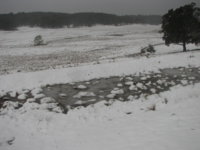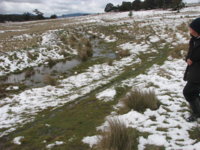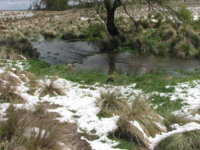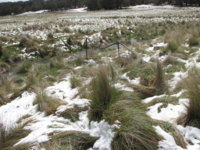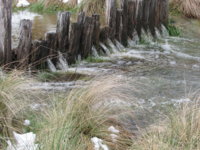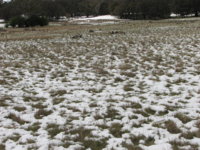The Old Ram-Australia
Herd Master
- Joined
- Jan 18, 2011
- Messages
- 978
- Reaction score
- 2,066
- Points
- 303
G’day it is generally acknowledged that “grass” is the most efficient form of raising livestock.
KNOW what you have.
KNOW what you need.
KNOW how to manage its production.
In the main pastures are made up of species that are Native or Exotic. In both cases they fall into one of three classes. Warm season, Cool season and year round. On our place the year round are Natives and respond whenever we get some rain.
Know what you have: take some time to learn about what you have by way of species through reading or getting someone from the local authority to come and identify for you. Generally speaking most of your annuals will be warm season, but it’s the perennials that you need to encourage for the long term and that entails “not driving “ the crowns too hard at the end of spring and wherever possible after the spring thaw let at least some of your paddocks to rest and re-seed especially after a dry spell.
In the U.S.A.I suspect in days of old (before the coming of the white fella) the range lands would have had a stand of “dry feed” when the first snows arrived and when it “fell over” it would have formed a blanket between the snow and the ground, thus lessening the depth that the ground froze. So it seems to me that if you graze the land “hard” leaving little or no cover when the first snow arrives it will freeze the soil deeper and when the thaw comes the frozen ground will repel the moisture and run off thus you are getting minimal penetration of the moisture into the soil to sustain it through the dry period of the summer.
Know what you need: It is usual for paddocks to have a mix of warm and cool and if you are lucky some year round as well. After the fall break spend some time looking at what you have in which paddocks and “plan” how you can increase the shortfalls of either type this will entail “locking” up a particular paddock and let the grass flower and seed for the length of the season. In one of our40 ac paddocks we fenced it into 4 grazing paddocks and in the middle fenced out about 1 ac which we rarely graze and so it tends to grow flower and seed throughout the 4 seasons and the resulting seed is carried by wind, wildlife and the sheep into the other 4 which surround it and over time we have increased the diversity in all 5 for the benefit of the stock.
Management takes planning: but success in the main comes from “planning” .IMO, the better the plan the better the outcome and the reduction in COP and ultimately the profit outcome.
Part of the following was influenced by the writings of Em.Prof. Fred Provenza in his most recent book titled “Nourishment”. It would seem that diversity of forage species increases the diversity of gut bacteria in the grazing animal and this diversity means that the animal gets the maximum growth from the material consumed. I am sure we have all experienced the result of a “sudden” feed change our animals because the gut bacteria was the wrong type to cope.
For many years now I have used the term “Wire grows grass” .Because I believe that the more paddocks you have the “more control” you have. If your pasture is a single or even a duo species type it will never be as good as a “wild meadow pasture “for animal health”…E.G. I like Bacon, but bacon for breakfast, smoko, lunch, smoko, dinner and supper. How many days would I last on that diet? Down here is was and is common practice to sow Oats in late summer ,graze in mid winter and at lambing put the late stage ewes into the crop for lambing. Generally speaking this will result in a Calcium deficiency in the lactating ewes and force her to mobilize her own reserves which for twin bearing ewes are in fact quite dangerous for the health of both ewes and lambs.
Many of you will know that retaining moisture is my “thing” and over the years I have devoted a lot of time, energy and thinking time to the subject, so here are a couple of photos to illustrate what we have observed over the years.
Pic 1.Shows the swale acting as a giant bathtub.
Pic 2.shows the melting snow being held prior to being absorbed.
Pic 3/4.shows the volume being discharged.
Pic 5.Shows the effect of the structure on the speed of the flow.
Pic 6.Our ewe flock was lambing at the time “outdoors”.
KNOW what you have.
KNOW what you need.
KNOW how to manage its production.
In the main pastures are made up of species that are Native or Exotic. In both cases they fall into one of three classes. Warm season, Cool season and year round. On our place the year round are Natives and respond whenever we get some rain.
Know what you have: take some time to learn about what you have by way of species through reading or getting someone from the local authority to come and identify for you. Generally speaking most of your annuals will be warm season, but it’s the perennials that you need to encourage for the long term and that entails “not driving “ the crowns too hard at the end of spring and wherever possible after the spring thaw let at least some of your paddocks to rest and re-seed especially after a dry spell.
In the U.S.A.I suspect in days of old (before the coming of the white fella) the range lands would have had a stand of “dry feed” when the first snows arrived and when it “fell over” it would have formed a blanket between the snow and the ground, thus lessening the depth that the ground froze. So it seems to me that if you graze the land “hard” leaving little or no cover when the first snow arrives it will freeze the soil deeper and when the thaw comes the frozen ground will repel the moisture and run off thus you are getting minimal penetration of the moisture into the soil to sustain it through the dry period of the summer.
Know what you need: It is usual for paddocks to have a mix of warm and cool and if you are lucky some year round as well. After the fall break spend some time looking at what you have in which paddocks and “plan” how you can increase the shortfalls of either type this will entail “locking” up a particular paddock and let the grass flower and seed for the length of the season. In one of our40 ac paddocks we fenced it into 4 grazing paddocks and in the middle fenced out about 1 ac which we rarely graze and so it tends to grow flower and seed throughout the 4 seasons and the resulting seed is carried by wind, wildlife and the sheep into the other 4 which surround it and over time we have increased the diversity in all 5 for the benefit of the stock.
Management takes planning: but success in the main comes from “planning” .IMO, the better the plan the better the outcome and the reduction in COP and ultimately the profit outcome.
Part of the following was influenced by the writings of Em.Prof. Fred Provenza in his most recent book titled “Nourishment”. It would seem that diversity of forage species increases the diversity of gut bacteria in the grazing animal and this diversity means that the animal gets the maximum growth from the material consumed. I am sure we have all experienced the result of a “sudden” feed change our animals because the gut bacteria was the wrong type to cope.
For many years now I have used the term “Wire grows grass” .Because I believe that the more paddocks you have the “more control” you have. If your pasture is a single or even a duo species type it will never be as good as a “wild meadow pasture “for animal health”…E.G. I like Bacon, but bacon for breakfast, smoko, lunch, smoko, dinner and supper. How many days would I last on that diet? Down here is was and is common practice to sow Oats in late summer ,graze in mid winter and at lambing put the late stage ewes into the crop for lambing. Generally speaking this will result in a Calcium deficiency in the lactating ewes and force her to mobilize her own reserves which for twin bearing ewes are in fact quite dangerous for the health of both ewes and lambs.
Many of you will know that retaining moisture is my “thing” and over the years I have devoted a lot of time, energy and thinking time to the subject, so here are a couple of photos to illustrate what we have observed over the years.
Pic 1.Shows the swale acting as a giant bathtub.
Pic 2.shows the melting snow being held prior to being absorbed.
Pic 3/4.shows the volume being discharged.
Pic 5.Shows the effect of the structure on the speed of the flow.
Pic 6.Our ewe flock was lambing at the time “outdoors”.

